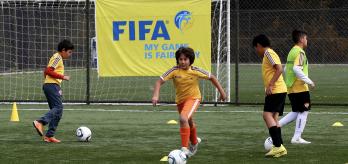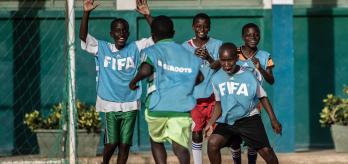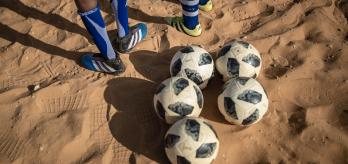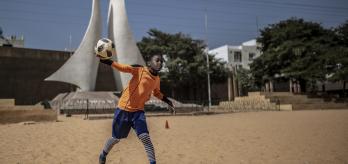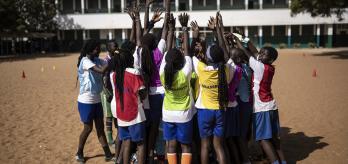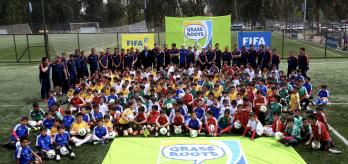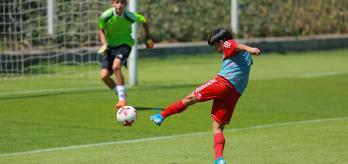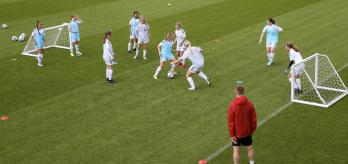Warm-up: Passing and movement
Organisation
- Split your group into two – half work inside the area, half spread themselves around the outside
- Players in the middle find a free outside player and approach them to receive a pass in the air or on the ground
- They return the ball to a different outside player, then go to find another one. Explain to the players that by passing the ball to different players in the area, they're utilising all the space and surface; as opposed to one space being worn out
- Vary the types of serve to challenge the players on the inside. Explain that if a player is to generate new skills, they must practice new ways of touching a ball. Otherwise, if a player uses the same skill (or foot) all the time, we are wasting our potential
- Make a completion, first player to complete a pass to each of the players on the outside wins. This promotes the message of not using the same resources more than once, enabling that resource (the player) to recover and regenerate their confidence and improve their awareness of others around them
- Swap the inside players with the outside players
Ways to make the exercise easier
- Make the area smaller, decreasing the physical challenge
- Allow players to catch the ball first and then return it
Ways to make the exercise harder
- Increase the size of the area
- Serves can vary or be random so the receiving player has to decide quickly how they will control and return it
Great questions to ask the children
- Can you show me your best techniques to return the ball?
- How can you let the outside player know when you are ready to receive the ball? By moving in different directions, standing in unused areas of the pitch, you will be able to communicate why using these spaces is good for the other players and spaces
- Is it possible to play it back using one touch – what affects this decision?
Safety tips
- Outside players should only pass the ball once they have been called by the receiving player
Skill development: Shooting
Organisation
- 4v1 in each half, plus goalkeepers
- 4v1 in the attacking half to start with, for close‑range shooting opportunities and early success
- Then 4v1 in the defending half and long‑range shooting from own half
- The one player in each half acts as a defender when his or her team is not in possession or a lone attacker when his or her team is in possession
- Encourage creative ways from the attacking player and rebounds.
- The four defenders can combine with their lone attacker to set up shots
Ways to make the exercise easier
- Start with no goalkeepers
Ways to make the exercise harder
- Require one-touch finishes in the attacking half
Great questions to ask the children
- What technique should you use for long‑distance shooting?
- Can you create space as a team of four to work a shooting opportunity?
- If you are defending, can you be brave and try to block shots?
Safety tips
- Players should stay in their own halves and concentrate at all times
Game application: Small sided game with long range shooting
Organisation
- Up to 6v6 normal game with goalkeepers
- Create a middle area: all players can only shoot from this area
- Try to have a wide pitch, to encourage different types of shots
- Players can also score from a rebound if the goalkeeper makes a save
- Rotate goalkeepers and make sure there are spare balls in the goals if you have them
Ways to make the exercise easier
- Allow players to shoot from anywhere to begin with
Ways to make the exercise harder
- Ask players to shoot with their weaker foot
- Ask players to set up first-time shooting opportunities
Great questions to ask the children
- What techniques can you use to shoot from distance?
- Can you observe the position of the goalkeeper before you shoot?
- Can at least one player try to follow up every shot for possible rebounds?
Safety tips
- Create safe zones between pitches and make sure children have warmed up and stretched before shooting practice






